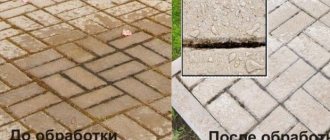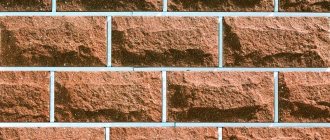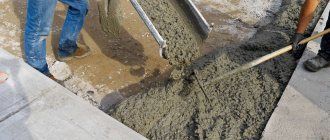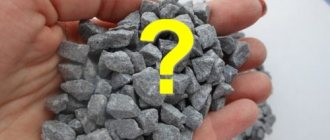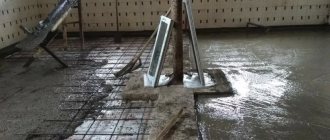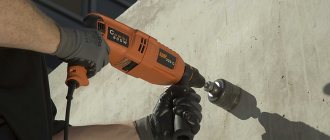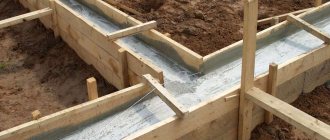Question. Hello! I poured the floor screed under the parquet board. If you put parquet on a damp base, it will develop fungus and disappear. Is it possible to somehow measure the moisture content of concrete or is everything done by eye?
Answer. Good afternoon There are two technologies for determining the moisture content of concrete: alternative “old-fashioned” technology and instrumentometric technology. The latter, in turn, is divided into conductometric and dielcometric methods. Which one to choose is up to you.
Moisture meters: description and principles of operation
A moisture meter is a device for measuring the absolute moisture content in gaseous, solid and bulk materials. An example is a regular hygrometer, although moisture meters for concrete have a slightly different design and operating principle. With the help of such a device, it is possible to comply with technological requirements for concrete structures, improve their quality and durability.
Humidity measuring instruments
There are a large number of methods for assessing moisture content, but only a few of them can be used to obtain data on the condition of concrete . They form the basis for the functioning of moisture meters:
- Conductometric method. A needle moisture meter works using this method. The device has two sharp needles that plunge into the material. After switching on, electrical resistance arises between the needles, based on which the moisture content of the concrete is automatically calculated. This method is considered simple, fast, but cannot fix humidity less than 5%. The needles will leave noticeable marks on the concrete, which in some situations can reduce the aesthetics of the structure.
- Dielcometric method. It is used in in-line moisture meters equipped with a radio frequency generator. The latter measures the degree of dielectric constant of concrete. To carry out measurements, the sensor of the device is pressed against the surface being assessed. After the work was completed, there was no damage to the concrete. The disadvantages include the high cost and the risk of obtaining incorrect data if the sensor is not pressed tightly.
Device for measuring humidity using the conductometric method
Nowadays, modern electronic devices are most often used to measure the moisture content of concrete, which are no less suitable for other materials, including wood.
Standards for indicators
Conditions for the occurrence and components of acid-base reaction in concrete.
Humidity is determined in accordance with accepted standards that define the quality of material for industrial, residential and other buildings, works, and fences. Today the following moisture content standards have been adopted:
- 13% – for public and residential buildings, domestic buildings, industrial buildings;
- 15% – for residential buildings, industrial buildings, if the composition includes perlite sand or ash;
- 18% – only for industrial buildings.
When dispensing ready-made products, the humidity should not exceed 25% if the solution was mixed on the basis of sand, and no more than 35% if the solution was mixed on the basis of ash, a waste product for cellular concrete.
Types of moisture meters
Based on the method of interaction with the material being studied, all devices can be divided into contact devices, which are inserted inside, and non-contact devices, which are only brought to the surface. Depending on their purpose, devices can be universal or highly specialized, although the former are more common and more popular. In addition, there are devices for wood that are equipped with an additional sensor for concrete - they are considered the most convenient in construction and repair.
Carbide moisture meter
Other types of moisture meters are:
- soil moisture analyzers - allow you to determine whether the soil is suitable for construction work;
- carbide - generate a low-frequency electric field, are equipped with a large number of electrodes, can determine humidity from 0% to 4-6%;
- multi-channel - they carry out calculations remotely and have a built-in thermometer.
Standards for indicators
Conditions for the occurrence and components of acid-base reaction in concrete.
Humidity is determined in accordance with accepted standards that define the quality of material for industrial, residential and other buildings, works, and fences. Today the following moisture content standards have been adopted:
- 13% – for public and residential buildings, domestic buildings, industrial buildings;
- 15% – for residential buildings, industrial buildings, if the composition includes perlite sand or ash;
- 18% – only for industrial buildings.
When dispensing ready-made products, the humidity should not exceed 25% if the solution was mixed on the basis of sand, and no more than 35% if the solution was mixed on the basis of ash, a waste product for cellular concrete.
Areas of application of moisture meters in construction
Moisture meters for concrete, brick, screed allow you to determine how high the quality of these materials is. When pouring concrete mass and cement screed, it is not always possible to determine “by eye” and by the deadline whether the structure is ready for use. Only the use of a special meter will make it possible to obtain accurate figures and compare them with those allowed in SNiP. If you continue to work with concrete too early, you can deteriorate the properties of the structure or damage its surface.
In addition, a moisture meter will help determine whether it is possible to glue wallpaper or paint walls after applying plaster. This is especially important in industry and multi-apartment construction, where the slightest miscalculation can lead to serious consequences. Moisture meters are also in high demand in the following areas:
- construction of a foundation without waterproofing;
- production of concrete and reinforced concrete products;
- pouring arches, bridges, supports;
- monolithic construction.
Concrete wall moisture measurement
Concrete moisture tolerances
The maximum permissible moisture content of concrete for construction is 5.5%. For cement screed this figure should not exceed 6.5%, for cement mortar - 4%, for plaster - 0.6%. If these standards are not observed, the strength of structures and their service life may change for the worse.
GOST 12730.2-78 “Concrete. Method for determining humidity"
STATE STANDARD OF THE USSR UNION
| CONCRETE Humidity Determination Method Concrete. Method of determination of moisture content | GOST 12730.2-78 |
Date of introduction 01/01/80
This standard applies to all types of concrete and establishes a method for determining moisture content by testing samples.
GENERAL REQUIREMENTS
1.1. General requirements for the method for determining the moisture content of concrete are in accordance with GOST 12730.0.
EQUIPMENT AND REAGENTS
2.1. To carry out the test use:
— laboratory scales according to GOST 24104;
— drying cabinet according to GOST 13474;
— desiccator according to GOST 25336;
- baking trays;
— calcium chloride according to GOST 450.
PREPARATION FOR THE TEST
3.1. The moisture content of concrete is determined by testing samples or samples obtained by crushing samples after their strength testing or extracted from finished products or structures.
3.2. The largest size of crushed pieces of concrete should be:
- for heavy concrete and concrete with porous aggregates - no more than the maximum size of aggregate grains;
- for fine-grained concrete (including cellular and silicate) - no more than 5 mm.
3.3. An average sample weighing at least:
1000 g - for heavy concrete and concrete with porous aggregates;
100 g - for cellular, silicate and fine-grained concrete.
During production control of concrete moisture in concrete and reinforced concrete products, it is allowed to test concrete samples of smaller mass in accordance with the requirements of the standards for these products.
3.4. Samples or specimens are crushed and weighed immediately after sampling or stored in a vapor-tight package or airtight container, the volume of which is no more than twice the volume of the samples placed in it.
CONDUCTING THE TEST
4.1. The prepared samples or specimens are weighed, placed in a drying cabinet and dried to constant weight at a temperature of (105 ± 5) °C.
The mass of a sample (sample) is considered constant if the results of two consecutive weighings differ by no more than 0.1%. In this case, the time between weighings should be at least 4 hours.
4.2. Before re-weighing, the sample(s) are cooled in a desiccator with anhydrous calcium chloride or together with a drying oven to room temperature.
4.3. Weighing is carried out with an error of up to 0.01 g.
4.4. The collected moisture content of heavy concrete, concrete with porous aggregates and silicate concrete is determined according to the GOST 12852.6 method.
In this case, the sample weight of heavy concrete and concrete on porous aggregates, depending on the largest size of the aggregate grains, is taken according to the table.
| Largest grain size filler, mm | Sample weight, g |
| 20 or less | 100 |
| 40 | 200 |
| More than 40 | 500 |
PROCESSING RESULTS
5.1. The moisture content of concrete sample (sample) by mass Wm in percent is calculated with an error of up to 0.1% using the formula
(1)
where is the mass of the concrete sample (sample) before drying, g;
— mass of concrete sample (sample) after drying, g.
5.2. The moisture content of concrete sample (sample) by volume Wo in percent is calculated with an error of up to 0.1% using the formula
(2)
where is the density of dry concrete, determined according to GOST 12730.1, g/cm3;
— density of water, taken equal to 1 g/cm3.
5.3. The moisture content of concrete of a series of samples (samples) is determined as the arithmetic mean of the results of determining the moisture content of individual samples (samples) of concrete.
5.4. The journal in which test results are recorded must contain the following columns:
— marking of samples;
— place and time of sampling;
— moisture state of concrete;
— age of concrete and test date;
— moisture content of concrete samples (samples) and series by weight;
— moisture content of concrete samples (samples) and series by volume.
INFORMATION DATA
1. DEVELOPED
USSR State Committee for Construction Affairs
Ministry of Construction Materials Industry of the USSR
Ministry of Energy and Electrification of the USSR
DEVELOPERS
M. I. Brusser, Ph.D. tech. Sciences (topic leader); L. A. Malinina, Dr. tech. sciences; A. T. Baranov, Ph.D. tech. sciences; G. A. Buzhevich, Ph.D. tech. sciences; L. I. Karpikova, Ph.D. tech. sciences; T. A. Ukhova, Ph.D. tech. sciences; Yu. A. Savvina, Ph.D. tech. sciences; Yu. A. Belov; V. L. Rubetskoy; N. V. Myakoshin; V. G. Dovzhik, Ph.D. tech. sciences; V. A. Piskarev, Ph.D. tech. sciences; G. Ya. Amkhanitsky, Ph.D. tech. sciences; S. N. Levin, Ph.D. tech. sciences; E. N. Leontiev, Ph.D. tech. sciences; V. N. Tarasova, Ph.D. tech. sciences; L. I. Levin; V. A. Dorf, Ph.D. tech. sciences; Yu. G. Khayutin, Ph.D., Tech. sciences; V. B. Sudakov, Ph.D. tech. sciences; Ts. G. Ginzburg, Ph.D. tech. sciences; R. E. Litvinova, Ph.D. chem. sciences; A. G. Malinovsky
INTRODUCED by the USSR State Committee for Construction Affairs
2. APPROVED AND ENTERED INTO EFFECT by Resolution of the USSR State Committee for Construction Affairs dated December 22, 1978 No. 242
3. INSTEAD GOST 12852.2-77, GOST 11050-64 regarding determination of humidity
4. REFERENCE REGULATIVE AND TECHNICAL DOCUMENTS
5. REPUBLICATION. June 1994
content
files.stroyinf.ru
Device selection
When purchasing a device, you need to take into account the purpose of its use and the expected volume of work. The ideal option is to choose a model included in the State Register of Measuring Instruments, although a regular, inexpensive device purchased on popular Internet sites is also suitable for home use. Some universal gadgets cannot boast of high measurement accuracy: it is better to purchase a special-purpose moisture meter.
Among the needle devices there are so-called deep ones: they have larger dimensions and long probes that penetrate deep into the structure of the material and accurately reflect the amount of moisture. Such devices provide detailed information, but are quite expensive and require very careful handling. Contactless gadgets are most convenient for independent use, although the most accurate ones are more expensive.
It is also worth paying attention to additional options:
- calculating the average humidity value - important when carrying out a large volume of measurements in different samples;
- measuring temperature and humidity in the environment - necessary for timely adjustment of the indoor climate;
- saving the results in the device’s memory, identifying the minimum and maximum indicators.
The error limit in instruments is usually 0.1-5%. For professional use, you need to focus on an error of no more than 0.5%, for home construction - 2-3%.
How to calibrate a gadget
Some moisture meters for concrete are sold already calibrated, others need to be configured independently. A number of devices are equipped with screws to move the pointer, while others need to be disassembled to move the scale. In any case, the instructions for the device always indicate how to calibrate it and whether such a need exists before first use.
Alternative technology
The moisture content of concrete is determined using plastic film and tape. The essence of the method is as follows:
- A square piece of polyethylene film measuring 1x1 meter is laid on the surface of the base;
- All sides of the square are glued with tape to the base. It is allowed to ensure a tight fit in any other way. For example, wooden planks pressed on top with some kind of weight;
- Holding at above-zero temperatures for 24 hours.
The presence of droplets of moisture on the side of the film facing the concrete indicates that the base has not yet dried out. Advantages: accessibility, speed, simplicity and low cost. Disadvantages: inability to determine the digital humidity value.
The best models of moisture meters for concrete
In stores you can find the following devices suitable for determining the moisture content of concrete structures:
- "Megeon 20550". Works with a variety of raw materials, quickly and reliably determines moisture content, temperature, and mass of bulk materials. Works in the range of 3-35%.
- TESTO 606-1. Portable digital device with large LCD display. The permissible humidity of building materials during measurements is 0.9-22.1%. Easy to use, compact.
- CEM DT-172. The Chinese device weighs only 80 g, easily and accurately measures the ambient temperature and the amount of moisture in materials. It is possible to transfer data via USB.
- CONDTROL Hydro-Test 3-14-022. Suitable for various areas of construction and woodworking. Analyzes the received data in 2 seconds, easy to manage.
Humidity meter Condtrol Hydro
Using a moisture meter you can seriously improve the quality of buildings being built or interior decoration. It should be in the arsenal of every master who values his work and strives to improve the efficiency of the work he performs.
Methods for determining water resistance
The water resistance of concrete is of great importance for structures that are operated in conditions of high humidity and also at low temperatures. That is why criteria for its assessment and methods for determining it are necessary.
GOST 12730.5-84 recommends the following methods for assessing the water resistance of concrete:
- According to the "wet spot". Water is applied to the sample in a special installation under pressure until it seeps out to the back side. The pressure is gradually increased and the value at which water will seep through the concrete is recorded.
- By filtration coefficient. Water is passed through the sample and the amount of filtrate and filtration time are measured.
Both of these methods are very time-consuming, so accelerated methods have been developed that are used more often:
- In terms of breathability.
- Measuring the filtration coefficient with a filtratemeter.
How can I get an accurate figure?
Professionals use special devices - moisture meters - to measure the moisture content of concrete screeds. With the help of these high-precision electronic assistants, it is possible to determine the moisture level of the concrete layer within a few seconds. These compact instruments also measure wood moisture. Moisture meters are expensive devices, so it is not advisable to buy them for one-time use. You can rent a moisture meter or carry out instrumental measurements by ordering a service from a specialized company.
How to speed up the drying of the mixture
If construction deadlines are tight, that is, it is not possible to wait for final hardening or it is not possible to ensure optimal humidity and temperature, it is permissible to use methods that help speed up hardening. These include:
- heating the solution at low air temperatures (steam, electricity, etc.);
- the use of additives to accelerate hardening;
- laying polyethylene on the surface, which retains the heat generated during hydration.
Carrying out construction work using concrete requires a special approach at each stage. If you approach the drying time of the mixture correctly, you can achieve increased strength of the building and avoid troubles associated with its deformation due to insufficient curing.
External waterproofing treatment of finished concrete surface
Methods for creating external waterproofing of concrete elements and structures:
- Traditional options are pasting and coating waterproofing of foundations and walls. This is a costly and ineffective method of preventing moisture from penetrating deep into a concrete structure. When using rolled waterproofing materials to treat foundations, it is necessary to install a protective screen, otherwise tears may occur in the panels when backfilling the pit.
- Penetrating waterproofing . The most famous representative of this group is Penetron, different types of which are used for volumetric (incorporation into a plastic mixture) and surface waterproofing. Penetrating waterproofing is commercially available as a dry powder or a finished liquid impregnating product. It consists of: Portland cement, filler and active chemical additives, the functions of which are performed by polymers or alkaline elements.
The action of penetrating waterproofing is based on its penetration deep into the concrete structure and reaction with the constituent components of cement stone. As a result of the reaction, water-insoluble crystals are formed in the pores, preventing the penetration of water. This material, applied to wet substrates, is intended for above-ground and underground objects. If the integrity of the surface is damaged, the effectiveness of waterproofing does not decrease. Peneplag quick-setting compounds are designed to eliminate gushing leaks.
- Waterproofing materials to protect seams from water penetration. A complex of Penebar gasket and Penecrit mortar allows you to protect concrete structures from water penetration through the seams.
The method of increasing the water resistance of a concrete element or structure is selected depending on the level of ambient humidity, the water pressure affecting the object, and the responsibility of the object.
- Builder with 20 years of experience
- Expert
In 1998 he graduated from St. Petersburg State Polytechnic University, studied at the department of civil engineering and applied ecology.
Engaged in the development and implementation of measures to prevent the release of low-quality products.
Develops proposals for improving the production of concrete and mortars.
Methods for determining water resistance according to GOST
According to the rules specified in GOST 26633-2012 “Fine-grained and heavy concrete. Technical specifications" water resistance is determined by the following methods:
- "Wet spot" method . The maximum pressure at which liquid does not pass through a concrete sample is measured. The study takes several days (up to 10 or more). For research, a special installation with 6 “nests” and a water supply through the lower end part is required.
- Determination of filtration coefficient. It is carried out according to the measured amount of filter and the time spent. In addition to a special mechanism, you need scales and silicate gel.
- Accelerated method. Based on the resistance to air penetration. This method is used most often because the waste of time is minimal. The research device is called a filtratemeter.
But, in addition to the main ones, there are additional methods for determining the water resistance of concrete:
- According to the cell structure of the materials (how much sand and gravel is included in the mixture).
- By type and volume of chemical additives (is silicate glue, ferric chloride, calcium nitrate, sodium oleate present in the concrete).
- By the type of substance binding the solution (whether it contains Portland cement, hydrophobic or pozzolanic cement).
